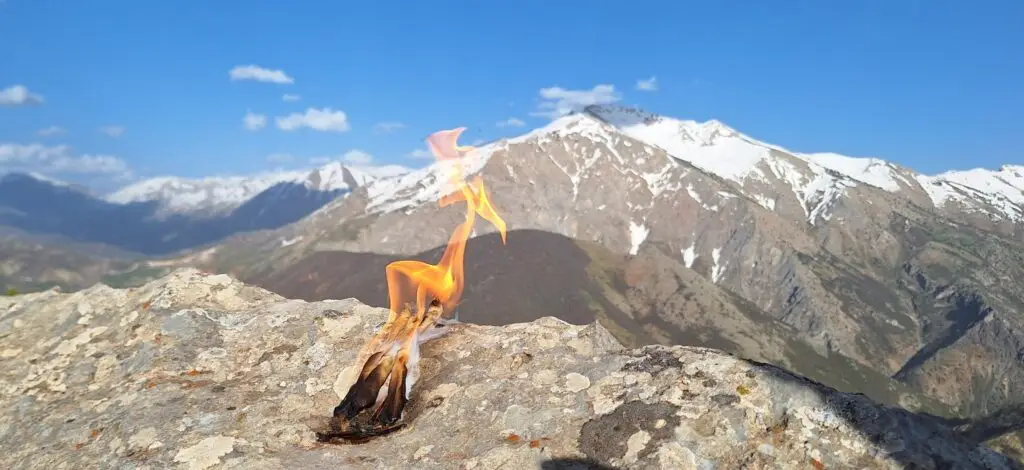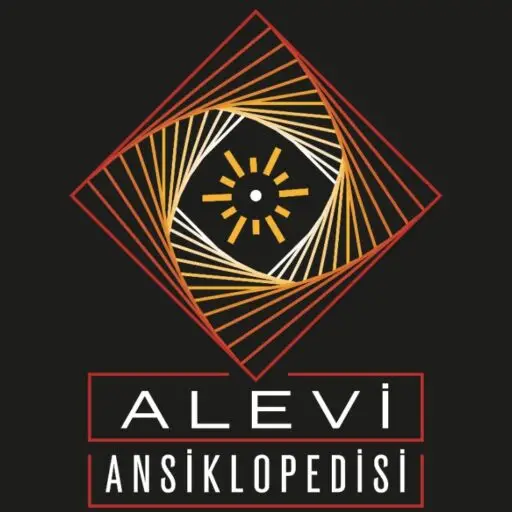Jiare /Ziyaret - (Sacred Places & Objects) in Raa Haqi (Dersim Alevism)
The jiare tradition embodies a cosmology where nature is animated and personified, and where divine presence is accessed through local geographies and mytho-historical narratives. Rituals such as lighting candles, offering niyaz (sacred food), or performing semah dances are conducted durin cem ceremonies at jiare sites without the need for clerical mediation, allowing for a more horizontal and intimate religious experience. This structure contrasts with the hierarchical authority of the ocak system (sacred lineages-centred practice of Alevism), offering believers an alternative form of spiritual agency.
In the context of modernity, migration, socio-political repression and physical violence, jiare practices have evolved as key mechanisms for the cultural and spiritual resilience of the Kurdish Alevi community both in Dersim and in the Western European diaspora. From the defence of sacred mountains against mining projects to the diasporic revival of Dersim identity through erected statues in Germany, the jiare serves as a dynamic axis for articulating identity, resistance, and belonging. As such, it reveals how indigenous cosmologies, such as Raa Haqi, adapt to contemporary conditions while maintaining their rootedness in ancestral landscapes.
Introduction: Raa Haqi Cosmology and the Sacred Landscape of Dersim
Among Kurdish Alevis of Dersim (followers of the Raa Haqi, in Kırmancki [The Path of the Truth]; ziyaret, in Turkish) the concept of jiare (sacred place or object) offers a radically different mode of engaging with the divine, the landscape, and communal identity. Far from being static sites of collective memory or conventional pilgrimage destinations, jiares are understood as animate, agentive, and relational nodes in a vibrant cosmology shaped through practices of walking, vowing, remembering, and resisting. Rooted in the Batın (inner/hidden) world of Raa Haqi cosmology, they function as intermediaries between the living and the unseen realm, between terrestrial and ancestral geographies, and between the social body and the land itself. This entry explores jiare not merely as “sacred place or object,” but as a critical epistemological and ontological category within Kurdish Alevi daily life, ritual, and cosmopolitics.
To understand the vitality of jiares, one must situate them within the broader cosmology of Raa Haqi—an internally coherent, non-textual religious world that challenges dominant categories of “religion” and “Islam.” Raa Haqi is not reducible to theological abstraction but is lived as a situated knowledge system grounded in nature, collective memory, emotions and kinship. Unlike Abrahamic orthopraxic traditions, Raa Haqi expresses itself through embodied ritual, oral transmission, and relational ethics mediated by a dual religious authority structure: the Ocak lineages (hereditary sacred families) and the sacred places or objects themselves. As the political violence of the early 20th century—most decisively the 1938 Dersim massacre and the forced displacements of the 1990s—, modernisation and migration affected through the century severed the traditional networks between pirs and talips, jiares emerged as decentralised yet enduring axes of religious life, offering access to the Batın world, to the spirituality and the practice of the religion without clerical mediation in daily life (Gültekin 2019, 2020. Also see Deniz 2019, 45-75; Göner 2012; Gürtaş 2015, 309-37).
Pilgrimage to jiares, in this regard, is not an obligation but a deeply personalised form of spiritual encounter. Each site is inhabited by a mythic presence—such as Munzur, Kemere Duzgı (Düzgün Baba), or Xızır—and is tied to specific stories of transformation, sacrifice, or resistance. These are not metaphors but living genealogies, where landscape and memory interweave. The sacred geography of Dersim thus appears not as a backdrop but as a protagonist in the Raa Haqi cosmology: it is a land that breathes, listens, punishes, and forgives. Every element of this sacred landscape may act as a spiritual guide (with anthropomorphised features) when no human one is accessible or is not preferred (Gültekin 2022, 570-88).
This approach reframes Dersim not just as a historical region, but as jiar u diyar—a total sacred territory whose meaning is generated through everyday devotional gestures, collective rituals, and a politics of care toward land and community. In this sense, jiares become epistemic spaces where Alevis of Dersim reconstitute identity, memory, and religious belonging in ways that exceed both statist recognition frameworks and Sunni-Islamic orthodoxy. This entry argues that only by centring jiares as a concept and practice can we apprehend the distinctiveness of Raa Haqi, its resistance to colonial categories of “religion,” and its ongoing vitality in both Dersim and diaspora (Gültekin 2019).
The Meaning of Jiare: Beyond “Sacred Place”
In the cosmology of Raa Haqi, jiare (ziyaret, in Turkish) is not just a neutral “sacred place or an object” as rendered in common translations, but a deeply layered epistemic and ontological category. It encompasses a world of myth, ethics, ritual, and social order that is foundational to the lived religious reality of Kurdish Alevis in Dersim. The jiare system is not a peripheral folk tradition but one of the two main axes of religious authority in Raa Haqi—complementary to the hereditary Ocak system and, in many cases, functioning autonomously as an actor of divine and moral agency (Gültekin 2024a, 513–26; 2024b, 17–55; 2025, 405-29. Also see Gezik & Çakmak 2010).
In Kırmancki, the word jiare has a dual semantic field. First, it refers to “sacred relics”—personalised, objectified carriers of mystical power such as staffs, gloves, cups, sticks or locks. These are often inherited within Ocaks or “chosen” talip families, but what is remarkable is that it is believed the jiare itself chooses its guardian. This agency marks a theological break from Ocak authority: a relic may carry divine will from the Batın world, independent of institutional designation agency (Gültekin 2024a, 513–26; 2024b, 17–55; 2025, 405-29. Also see Gezik & Çakmak 2010).
Second—and more central to collective practice—jiare designates sacred landscapes: mountains, springs, trees, stones, caves, or even entire valleys. Unlike built religious structures, these places are not created but revealed, either through miracle, transmission, or mythic event. Many of these places are associated with Xızır, dervishes, or animal-guides, but their authority is not contingent on clerical recognition. Instead, their status emerges from their effect: their healing power, their miraculous stories, and their capacity to enforce ethical-moral codes agency (Gültekin 2024a, 513–26; 2024b, 17–55; 2025, 405-29).
Each jiare belongs to and embodies the Batın world—the hidden, layered reality that coexists with the visible (Zahir). This world is populated not just by prophets and saints but also mılaket (angelic beings), spirits, and elemental forces. Jiares, as nodes in this unseen network, are animated moral authorities. They are gendered, hierarchized, and regionally embedded. They may demand sexual abstinence, ritual silence, or ecological respect. Those who violate them risk spiritual retribution: illness, infertility, or social disorder agency (Gültekin 2024a, 513–26; 2024b, 17–55; 2025, 405-29).
As I (2020) have shown, the jiare system forms a multi-level sacred topology that maps directly onto Dersim’s clan-based, tribal, and regional social formations:
Household and Family Jiares: Often isolated in mountainous terrain, associated with individual families or small hamlets. These include mostly stones, guardian trees, or healing springs. They are often not associated with dervishes or Ocak lineages, but with direct experience and familial memory.
Local Nisange (Markers): “Signpost” jiares positioned on ridges or hills that face larger, more distant jiares. These function as spiritual surrogates—making it possible to “visit” powerful jiares symbolically when physical travel is impossible. They democratize access while acknowledging sacred hierarchy.
Regional Collective Jiares: These gather village clusters or entire valleys. They serve as ritual centers during calendrical events—especially during specific sacred weeks (like Xızır months). These sites embody higher spiritual prestige and often relate to the memory of saintly ancestors.
Macro-Lineage Jiares: These are linked to entire Ocak systems or intertribal networks. They are personified entities: Duzgı, Munzur, Xızır. Their reputational power extends beyond Dersim’s valleys. These sites possess mythic precedence, said to send “candles” or “flaming orbs” to lesser jiares—symbolizing spiritual communication and hierarchy.
Every jiare has an associated myth—narratives that are simultaneously moral, cosmological, and historical. These stories define proper behavior, organize social values, and legitimize land-based claims of communities. Their sanctity is not architectural but performative: it lives in the acts of vow, offering, storytelling, and ritual silence (Gültekin 2020).
Importantly, the jiare structure is also a map of a religio-political map —a decentralized, talip-centric religious authority that has survived even when Ocak structures have been fragmented. In contemporary times, jiare culture remains alive in practices of pilgrimage, seasonal ritual, and environmental resistance, especially in struggles against mining, tourism, and ecological degradation (Gültekin 2019).
By interpreting jiares as autonomous, plural, and active non-human subjects—deeply integrated into social, gendered, and political life—one could gain a fuller understanding of how Raa Haqi reproduces itself outside the state, outside orthodoxy, and through its own grammar of sacred place.
Jiare and the Dual Authority Structure: Ocak and Jiare
The Raa Haqi cosmology is structured around a dual mechanism of religious authority: the Ocaks representing the visible (Zahir) domain and the jiares representing the hidden (Batın) realm. Together, these two interdependent systems sustain the religious, moral, and social order of Kurdish Alevis in Dersim and its diaspora. Each axis regulates distinct yet overlapping dimensions of everyday life, shaping individual subjectivities, communal belonging, and ontological relationships with the sacred agency (Gültekin 2024a, 513–26; 2024b, 17–55; 2025, 405-29).
The Ocak system—composed of the hereditary networks of pirs and anas, raybers, mürşids —represents the formal, hierarchical framework of Raa Haqi. This Zahir realm is deeply entrenched in kinship-based organisation and socio-religious caste structures, where followers (talips) are ritually and socially bound to their respective Ocaks. The Ocak not only provides religious guidance but also structures the totality of communal life. Rituals such as the Cem, ancestor veneration, moral arbitration, and rites of passage are all officiated under the authority of Ocak leaders. Within this realm, Haq signifies not only divine truth but also epistemic access—truth that is socially mediated and must be attained through guided instruction and communal ritual discipline agency (Gültekin 2024a, 513–26; 2024b, 17–55; 2025, 405-29).
Ocaks also serve as mediators between the Zahir and Batın worlds. Only through the structured progression of talip > rayber > pir > mürşid can one gain access to deeper metaphysical knowledge. Historically, rural village life and the extended household formed the spatial base of this authority system, which is gendered but includes female spiritual figures (anas) in supportive roles. Furthermore, pirs are believed to perform miracles (keramet), momentarily bridging Zahir and Batın through acts of divine intervention.
The second axis of religious authority lies within the Batın world, populated by jiares and other non-human actors: wayırs, milakets (angelic beings), peris (fairies), and the spirits of saints or ancestors. Here, sacredness is not institutional but relational and experiential. The jiares function as independent moral agents with their own agency, gender, temperament, and affective presence. They are the epicentres of a decentralised, talip-driven religiosity that we may call “individual piety”—a spiritual form outside the administrative and ceremonial structures of the Ocak system agency (Gültekin 2024a, 513–26; 2024b, 17–55; 2025, 405-29).
Unlike communal Cem rituals, jiare-based worship is everyday and personal. Pilgrims engage with sacred places through rituals of touch, light, silence, water, and dream. These sites are not governed by a codified ritual protocol, nor are they mediated by pirs. In many cases, fictive kinships such as kirvelik are formed with jiares themselves—symbolic relations that grant legitimacy to moral claims and social behaviours. In this sense, jiares not only offer divine intercession but also function as validators of ethical life in the absence of human clerics (2022, 570-88).
Furthermore, jiares serve as autonomous pathways to hakikat—the inner truth that in the Zahir realm must be reached via guided learning, but here is accessed through personal mystical experiences. The dream, the niyaz, the miraculous cure, or even the encounter with a personified jiare all constitute moments where divine knowledge is imparted directly. In the Batın cosmology, feminine entities are notably prominent, and many jiares are gendered female, embodying compassion, fertility, or protection.
While both Ocaks and jiares are co-constitutive of Raa Haqi, the political and social transformations of the 20th century—especially the violent collapse of tribal networks of the 1938 and the forced displacement of the 1990s—have led to the widespread erosion of Ocak-based structures. The dissolution of rural, village-centered religious life and the migration of thousands to urban centers and Western Europe have severed many talips from their traditional Ocaks. However, the jiares have remained—sometimes physically, sometimes symbolically—as enduring spiritual anchors (Gültekin 2019, 2020).
In many cases, talips now reconstitute their religious lives almost entirely through jiare practices, adapting pilgrimage routes, maintaining vows, and even reproducing sacred geography in diaspora contexts. This shift marks a significant transformation in the balance of religious authority: the Batın has gained autonomy. While the Cem remains a communal ritual of Zahir, most daily religious life now unfolds through Batın interactions—dreams, sacred landscapes, personal miracles—rendering jiares the dominant mode of access to the sacred (Gültekin 2019, 2020).
This dual system is not merely complementary; it is also marked by subtle tensions. As I have argued agency (Gültekin 2022, 570-88; 2024a, 513–26; 2024b, 17–55; 2025, 405-29), the competition between Ocaks and jiares—especially over claims to religious legitimacy and social prestige—has long existed beneath the surface. In practice, the talips’ allegiance often shifts toward the more accessible and responsive authority: the jiare. In many cases, the spiritual prestige of a jiare can even rival or exceed that of an Ocak, especially when jiares are said to “send fire,” “appear in visions,” or “choose” their own guardians. Thus, in the Raa Haqi cosmology, religious authority is not monolithic but plural, flexible, and negotiated. It is a cosmology that allows for both institutional guidance and mystical autonomy—where the sacred is mediated through both bloodline and mountain, lineage and spring, pir and stone.
Ritual practices at jiares are deeply embodied, gender-inclusive acts of devotion rooted in the Batın cosmology of Raa Haqi. Core elements include niyaz (offering), kurban (blood- and bloodless-sacrifice), candle lighting, touching sacred stones, and sleeping to receive dreams. These rituals serve not only for healing and vow-fulfillment but also as forms of mourning and personal transformation. Music—especially deyişs—and sacred objects mediate emotional connection to the divine. Unlike Ocak-led ceremonies, jiare rituals are decentralised, often led by women or talips, reinforcing a democratized, affective religiosity grounded in landscape and lived experience (Gültekin 2020).
Sacred Topographies of Resistance: Jiare, Identity, and Transnational Struggles
In the Raa Haqi cosmology, jiare functions not only as a site of devotional encounter but also as a symbolic and material axis of political and ecological resistance. Over the last three decades, state-sponsored interventions—ranging from military operations that severely destroy the landscape, the hydropower dam constructions and mining projects to touristic “development” plans—have directly targeted sacred sites in Dersim. These attacks are not merely environmental; they are ontological assaults on the living cosmology of the Raa Haqi. In response, Alevis of Dersim have mobilized collective memory and ritual power through both local activism and diasporic digital campaigns. Social media networks, transnational community organisations, and youth collectives now frame environmental struggles not within secular ecological discourse, but as the defence of the sacred. The land is not a resource, but a relative. Resistance becomes a ritual act (Gültekin 2021, 225-43).
This re-sacralization of territory has been especially potent in the diaspora, where jiares have undergone processes of reinterpretation and reterritorialization (or place-making). Gravesites, memorial days, photo archives, and even online jiare ceremonies act as proxies for inaccessible sacred geographies. Through transnational festivals and community commemorations, the Batın world migrates—carrying its symbols, narratives, and moral codes. What was once whispered devotion becomes public performance; secret pieties become declarations of collective identity. This transition from the “hidden” to the “visible” reflects not a loss of authenticity but the emergence of a new modality of Raa Haqi religiosity shaped by displacement and transnational belonging.
In this context, jiare becomes a central epistemic and emotional anchor for Dersim identity—the layered identity that combines geography, memory, and faith. For Kurdish Alevis who have lost access to their Ocaks or home villages, the jiare offers a tangible continuity of belonging and practice. It is through the jiare that moral knowledge is inherited, social boundaries redrawn, and sacred kinships renewed. The revival of talip-led religion-making—especially in the absence of institutional authority—has allowed for the re-appropriation of heritage and the emergence of new discursive horizons: ecological spirituality, gender egalitarianism, ritual democracy, and a radical secularism that resists Sunni-Islamic (or Political Islamism) dominance not only by negation, but through ontological divergence (Gültekin 2021, 225-43).
Thus, the jiare is not only a cultural memory site or theological topos; it is an active agent in the construction of an alternative future. In both Dersim and diaspora, jiare-based practice represents a form of environmental cosmopolitics—where protection of land, preservation of ritual, and the reimagination of identity converge in acts of resistance that are simultaneously spiritual, ecological, and political.
Conclusion: Raa Haqi as a Religion of Place
In the Raa Haqi tradition, jiares are not passive remnants of myth but active, sentient archives of both cosmological truth and collective historical trauma. Each sacred site is layered with narrative: Düzgün Baba’s vanishing into the mountain to protect his vow, the milk-transmuted waters of Munzur, or the grieving riverbed of Halvori. These stories are not simply remembered—they are performed, walked, touched, and reactivated in each act of pilgrimage. They constitute an oral archive, transmitted intergenerationally through deyiş, bodily gestures, ritual silence, and the affective discipline of reverence. Through these practices, space itself becomes a form of knowledge—an epistemic field where history, identity, and belief converge.
Beyond the mythic layer, jiares also absorb and reflect more recent layers of memory: massacre sites from 1938, guerrilla graves from the 1990s. These layers of meaning inscribe pain and resistance into the landscape, making jiares into affective archives of survival. The Batın cosmology thus does not only hold the secrets of saints and spirits—it is also where unspoken histories dwell. In this sense, the jiare is simultaneously theological and political, sacred and wounded.
What emerges from this sacred geography is a model of religiosity radically grounded in place. Raa Haqi is not a religion of the book, nor a system of abstract doctrine. It is a religion of place—one in which meaning is inscribed in soil, stone, trees, animals and stream. To understand this ontology, one must think not through texts but through routes, gestures, textures, and silences. In this view, jiares are not simply devotional spaces but ontological anchors, where the metaphysical and the material are inseparable.
The implications of this are profound. Raa Haqi challenges dominant academic frameworks that reduce Alevism to a heterodox variant of Islam or a residual Sufi tradition. It invites, instead, a new anthropology of Alevism—one that centers embodied spatial practice, non-human agency, and indigenous epistemologies. Through the lens of the jiare, one can rethink Alevism not as a derivative formation but as an autonomous cosmology with its own conceptual grammar, ritual logic, and political imagination.
I suggest to understand the concept of jiare not merely through external theoretical frameworks such as spatial triads or memory typologies, but rather as an ontological category emerging from within the epistemic world of Raa Haqi cosmology. Unlike conventional spatial analyses that categorise place into physical, social, or symbolic dimensions, jiares dissolve such distinctions by functioning simultaneously as place, being, memory, and relational agency. They are not inert containers of meaning, but active participants in shaping ethical behaviour, communal remembrance, and spiritual orientation. This approach calls for a shift from representational to relational thinking, where jiares are not interpreted from the outside as objects of analysis, but encountered as living nodes of interaction within a sacred landscape. In doing so, we move toward an epistemological stance that grants authority to indigenous ontologies and recognizes the agentive role of sacred geography in the everyday lives of Raa Haqi practitioners.
In today’s context—marked by ecological crisis, forced migration, and eroded religious institutions—jiares continue to offer a resilient structure of belonging and resistance. They sustain moral memory, foster ecological ethics, and offer alternatives to hegemonic forms of religiosity. Whether invoked in diaspora rituals or defended against extractivist violence, jiares continue to shape the religious, social, and political life of Raa Haqi communities.
Thus, to walk the path of Haqi today is to walk through sacred geographies—mapped not by empires but by memory, myth, and care. The future of Raa Haqi, and perhaps a decolonial anthropology of Alevism more broadly, lies in this geography of the sacred—a terrain where every stone may speak, and every spring remembers.
References and Further Readings
Deniz, Dilşa. 2019. “Kurdish Alevi Belief System, Reya Heqi/Raa Haqi: Structure, Networking, Ritual and Function.” In Kurdish Alevis and the Case of Dersim: Historical and Contemporary Insights, edited by Erdal Gezik and Ahmet Kerim Gültekin, 45–75. Lanham: Lexington Books.
Gezik, Erdal. 2000. “Munzur ve Düzgün’ün Sır Oluşlarının Tarihsel Bir Analizi.” Munzur Etnografya Dergisi 4: 15–28.
Gezik, Erdal, and Hüseyin Çakmak. 2010. Raa Haqi – Riya Haqi / Dersim Aleviliği İnanç Terimleri Sözlüğü. Ankara: Kalan Yayınları.
Gültekin, Ahmet Kerim. 2004. Tunceli’de Kutsal Mekan Kültü. Ankara: Kalan Yayınları.
Gültekin, Ahmet Kerim. 2019. “Kurdish Alevism: Creating New Ways of Practicing the Religion.” HCAS Working Paper Series, No. 18. Leipzig: Leipzig University.
Gültekin, Ahmet Kerim. 2020. Kutsal Mekânın Yeniden Üretimi – Kemeré Dızgı’dan Düzgün Baba’ya Dersim Aleviliğinde Müzakereler ve Kültür Örüntüleri. İstanbul: Bilim ve Gelecek Kitaplığı.
Gültekin, Ahmet Kerim. 2021. “Dersim as a Sacred Land – Contemporary Kurdish Alevi Ethno-Politics and Environmental Struggle.” In Ecological Solidarity and the Kurdish Freedom Movement, edited by Stephen E. Hunt, 225–243. Maryland: Lexington Books.
Gültekin, Ahmet Kerim. 2022. “Kemerê Duzgı: The Protector of Dersim (Pilgrimage, Social Transformation and Revitalization of the Raa Haqi Religion).” British Journal of Middle Eastern Studies 49(4): 570–588. https://doi.org/10.1080/13530194.2022.2126350
Gültekin, Ahmet Kerim. 2024a. “Kutsal Toprak Dersim: Raa Haqi Mitolojisi, Jiare (Ziyaret) Ritüelleri ve Dersim Aleviliğinde Dinin Bireysel Boyutu.” In Dersim/Tunceli’nin Yüzyılı (1900–2000), edited by Mesut Özcan, 513–526. Tunceli: Oroji Yayınları.
Gültekin, Ahmet Kerim. 2024b. “Ewladê Raa Haqi: Die kurdischen Aleviten von Dersim.” In Dersim – Identität und Vernichtung, edited by Christian Gudehus and Alexander Husenbeth, 17–55. Gießen: Psychosozial-Verlag.
Gültekin, Ahmet Kerim. 2025. “Kendini Küllerinden Yaratan Kadim Bir Dini Yeniden Okumak: 21. Yüzyılda Yerini Arayan Raa Haqi (Dersim Aleviliği)”, içinde 100. Yılında Cumhuriyet ve Aleviler (ed. Ayhan Yalçınkaya & Mehmet Kendirci), pp 405-429. Ankara: Dipnot Yayınları.
Gültekin, Ahmet Kerim, and Erdal Gezik, eds. 2019. Kurdish Alevis and the Case of Dersim: Historical and Contemporary Insights. Lanham, MD: Lexington Books.
Gürtaş, İmran. 2015. “Dersim Alevilerinde Kimlik İnşası ve Travma.” In Kızılbaşlık, Alevilik, Bektaşilik: Tarih–Kimlik–İnanç–Ritüel, edited by Yalçın Çakmak and İmran Gürtaş, 309–327. İstanbul: İletişim Yayınları.
Göner, Özlem. 2012. A Social History of Power and Struggle in Turkey: State, Memory, Movements, and Identity of Outsiderness in Dersim. PhD diss., University of Massachusetts.




